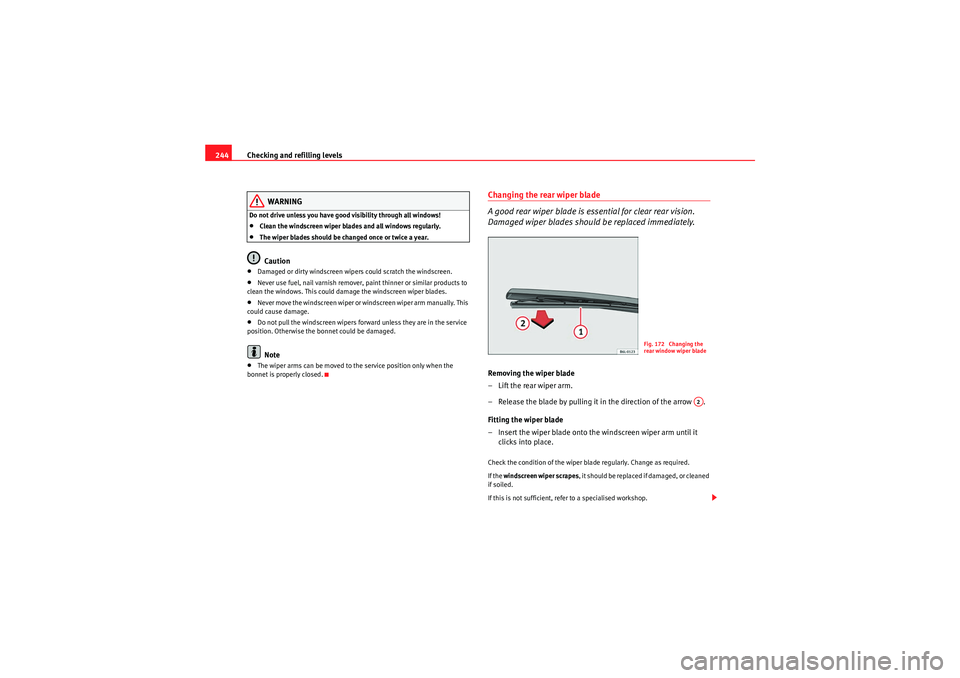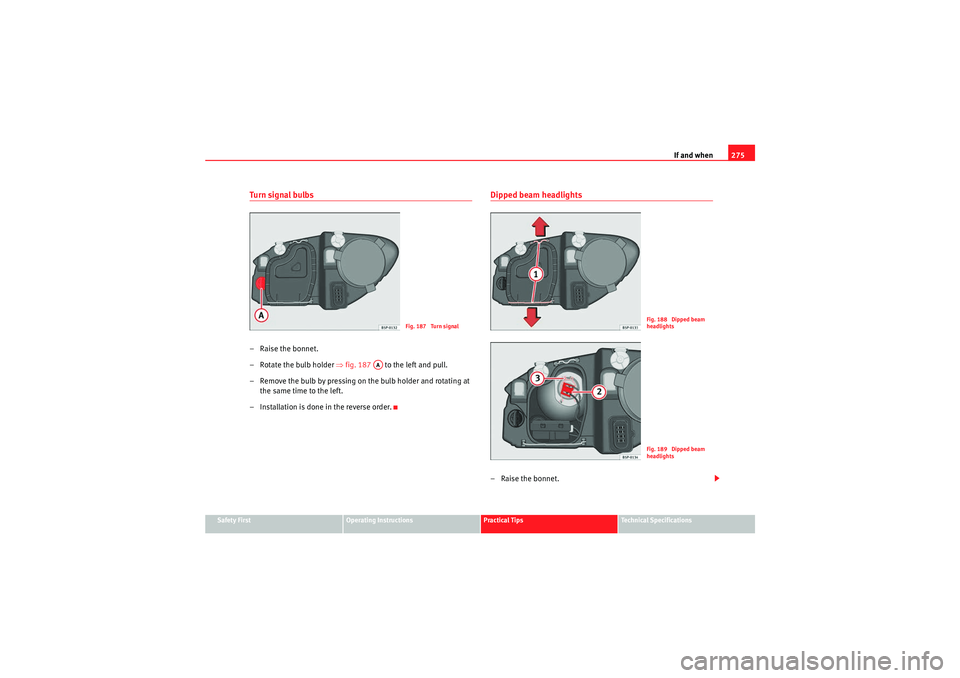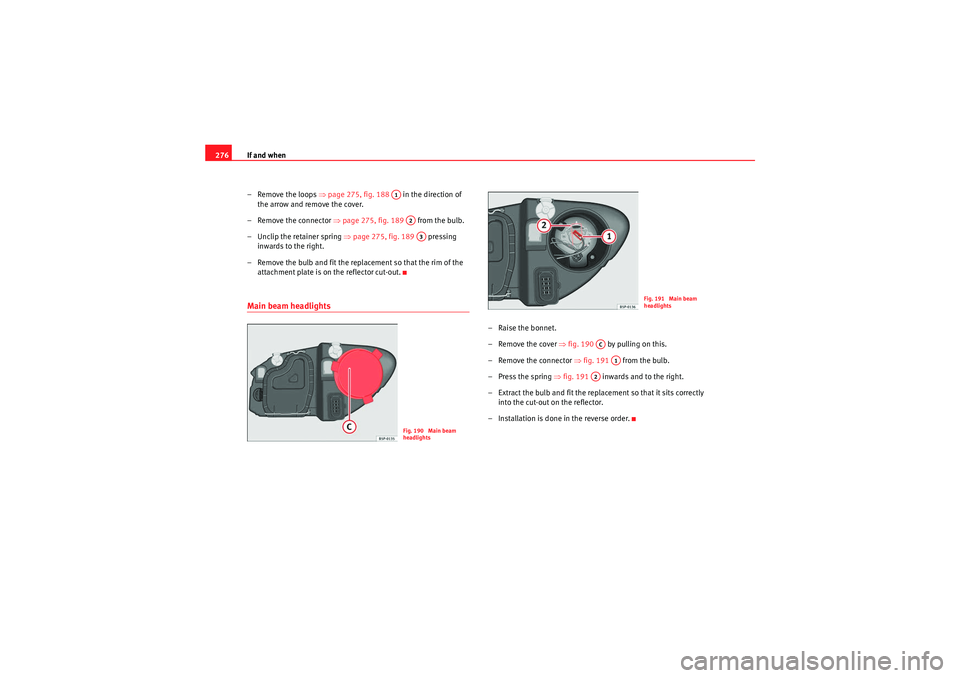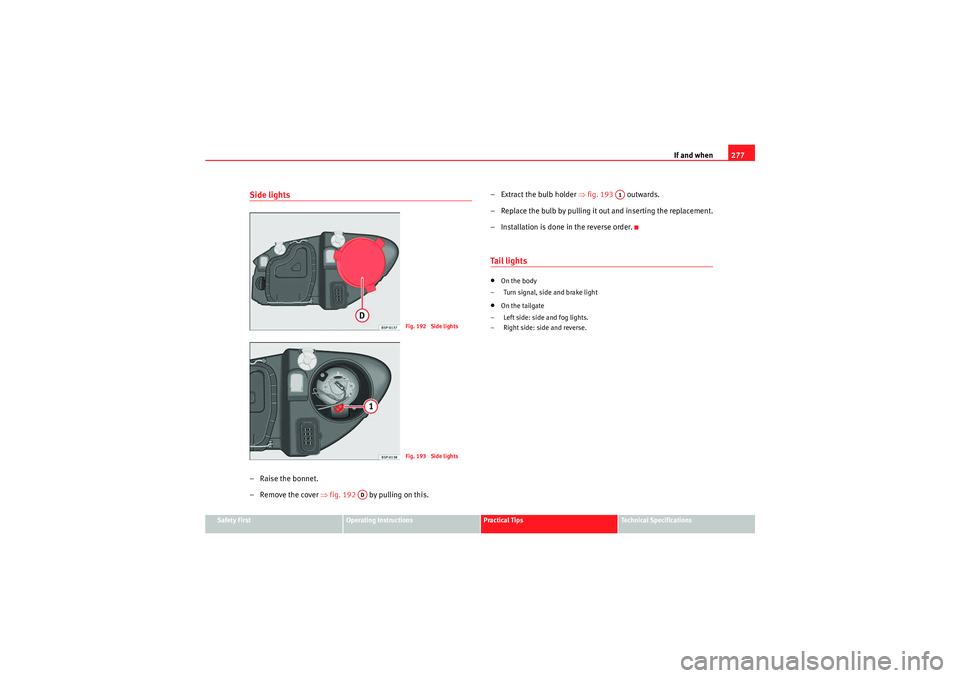2011 Seat Altea XL bonnet
[x] Cancel search: bonnetPage 246 of 319

Checking and refilling levels
244
WARNING
Do not drive unless you have good visibility through all windows!•Clean the windscreen wiper blades and all windows regularly.•The wiper blades should be changed once or twice a year.Caution
•Damaged or dirty windscreen wipers could scratch the windscreen.•Never use fuel, nail varnish remover, paint thinner or similar products to
clean the windows. This could damage the windscreen wiper blades.•Never move the windscreen wiper or windscreen wiper arm manually. This
could cause damage.•Do not pull the windscreen wipers forward unless they are in the service
position. Otherwise the bonnet could be damaged.Note
•The wiper arms can be moved to the service position only when the
bonnet is properly closed.
Changing the rear wiper blade
A good rear wiper blade is essential for clear rear vision.
Damaged wiper blades should be replaced immediately.Removing the wiper blade
– Lift the rear wiper arm.
– Release the blade by pulling it in the direction of the arrow .
Fitting the wiper blade
– Insert the wiper blade onto the windscreen wiper arm until it clicks into place.Check the condition of the wiper blade regularly. Change as required.
If the windscreen wiper scrapes , i t s h o u ld b e r e p la ce d i f d a m a ge d , o r c l ea n e d
if soiled.
If this is not sufficient, refer to a specialised workshop.
Fig. 172 Changing the
rear window wiper blade
A2
AlteaXL_EN.book Seite 244 Donnerstag, 9. September 2010 12:13 12
Page 248 of 319

Checking and refilling levels
246However, if the level goes down noticeably in a short time, or drops below the
“MIN” mark, there may be a leak in the brake system. A display on the instru-
ment panel will warn you if the brake fluid level is too low ⇒ page 77.
WARNING
Before opening the bonnet to check the brake fluid level, read and observe
the warnings ⇒page 233.Changing the brake fluid
The Maintenance Programme indicates the brake fluid
change intervals.We recommend that you have the brake fluid changed by an Authorised
Service Centre.
Before opening the bonnet, please read and follow the warnings ⇒ in
“Safety instructions on working in the engine compartment” on page 233 in
section “Safety notes for working in the engine compartment”.
Brake fluid absorbs moisture. In the course of time, it will absorb water from
the ambient air. If the water content in the brake fluid is too high, the brake
system could corrode. This also considerably reduces the boiling point of the
brake fluid. Heavy use of the brakes may then cause a vapour lock which
could impair the braking effect.
It is important that you use only brake fluid compliant with US standard
FMVSS 116 DOT 4. We recommend the use of Genuine SEAT brake fluid.
WARNING
Brake fluid is poisonous. Old brake fluid impairs the braking effect.
•Before opening the bonnet to check the brake fluid level, read and
observe the warnings ⇒page 233.•Brake fluid should be stored in the closed original container in a safe
place out of reach of children. There is a toxic risk.•Complete the brake fluid change according to the Maintenance
Programme. Heavy use of the brakes may cause a vapour lock if the brake
fluid is left in the system for too long. This would seriously affect the effi-
ciency of the brakes and the safety of the vehicle. This may cause an acci-
dent.Caution
Brake fluid could damage the paintwork. Wipe off any brake fluid from the
paintwork immediately.
For the sake of the environment
The brake pads and fluid must be collected and disposed of according the
applicable regulations. The SEAT Technical Service network has the necessary
equipment and qualified personnel for collecting and disposing of this waste
material.
WARNING (continued)
AlteaXL_EN.book Seite 246 Donnerstag, 9. September 2010 12:13 12
Page 250 of 319

Checking and refilling levels
248•If the vehicle is left standing in cold conditions for a long period, protect
the battery from freezing. If it freezes it will be damaged.Checking the electrolyte level
The electrolyte level should be checked regularly in high-
mileage vehicles, in hot countries and in older batteries.– Open the engine bonnet and the battery cover ⇒ in “Safety
instructions on working in the engine compartment” on
page 233 ⇒ in “Warnings on handling the battery” on
page 247.
– Check the colour display in the "magic eye" on the top of the battery.
– If there are air bubbles in the window, tap the window gently until they disperse.The position of the battery is shown in the corresponding engine compart-
ment diagram ⇒page 293.
The “magic eye” indicator, located on the top of the battery changes colour,
depending on the charge state and electrolyte level of the battery.
There are two different colours:•Black: correct charge status.•Transparent/clear yellow: the battery must be replaced. Contact a special-
ised workshop.
Charging and changing the vehicle battery
The battery is maintenance-free and is checked during the
inspection service. All work on the vehicle battery requires
specialist knowledge.If you often drive short distances or if the vehicle is not driven for long
periods, the battery should be checked by a specialised workshop between
the scheduled services.
If the battery has discharged and you have problems starting the vehicle, the
battery might be damaged. If this happens, we recommend you have the
vehicle battery checked by an Authorised Service Centre where it will be re-
charged or replaced.
Charging the battery
The vehicle battery should be charged by a specialised workshop only, as
batteries using special technology have been installed and they must be
charged in a controlled environment.
Replacing a vehicle battery
The battery has been developed to suit the conditions of its location and has
special safety features.
Genuine SEAT batteries fulfil the maintenance, performance and safety spec-
ifications of your vehicle.
WARNING
•We recommend you use only maintenance-free or cycle free leak-proof
batteries which comply with standards T 825 06 and VW 7 50 73. This
standard applies as of 2001.•Before starting any work on the batteries, you must read and observe
the warnings ⇒ in “Warnings on handling the battery” on page 247.
AlteaXL_EN.book Seite 248 Donnerstag, 9. September 2010 12:13 12
Page 277 of 319

If and when275
Safety First
Operating Instructions
Practical Tips
Technical Specifications
Turn signal bulbs– Raise the bonnet.
– Rotate the bulb holder ⇒fig. 187 to the left and pull.
– Remove the bulb by pressing on the bulb holder and rotating at the same time to the left.
– Installation is done in the reverse order.
Dipped beam headlights– Raise the bonnet.
Fig. 187 Turn signal
AA
Fig. 188 Dipped beam
headlightsFig. 189 Dipped beam
headlights
AlteaXL_EN.book Seite 275 Donnerstag, 9. September 2010 12:13 12
Page 278 of 319

If and when
276
– Remove the loops ⇒page 275, fig. 188 in the direction of
the arrow and remove the cover.
– Remove the connector ⇒page 275, fig. 189 from the bulb.
– Unclip the retainer spring ⇒page 275, fig. 189 pressing
inwards to the right.
– Remove the bulb and fit the replacement so that the rim of the attachment plate is on the reflector cut-out.Main beam headlights
– Raise the bonnet.
– Remove the cover ⇒fig. 190 by pulling on this.
– Remove the connector ⇒fig. 191 from the bulb.
–Press the spring ⇒fig. 191 inwards and to the right.
– Extract the bulb and fit the replacement so that it sits correctly into the cut-out on the reflector.
– Installation is done in the reverse order.
A1
A2A3
Fig. 190 Main beam
headlights
Fig. 191 Main beam
headlights
AC
A1
A2
AlteaXL_EN.book Seite 276 Donnerstag, 9. September 2010 12:13 12
Page 279 of 319

If and when277
Safety First
Operating Instructions
Practical Tips
Technical Specifications
Side lights– Raise the bonnet.
– Remove the cover ⇒fig. 192 by pulling on this. – Extract the bulb holder
⇒fig. 193 outwards.
– Replace the bulb by pulling it out and inserting the replacement.
– Installation is done in the reverse order.
Ta i l l i g h t s•On the body
– Turn signal, side and brake light•On the tailgate
– Left side: side and fog lights.
– Right side: side and reverse.
Fig. 192 Side lightsFig. 193 Side lights
AD
A1
AlteaXL_EN.book Seite 277 Donnerstag, 9. September 2010 12:13 12
Page 309 of 319

Index307
Index
AABS . . . . . . . . . . . . . . . . . . . . . . . . . . . . . . . . . . . 198
Warning lamp . . . . . . . . . . . . . . . . . . . . . . . . . 84
Accessories . . . . . . . . . . . . . . . . . . . . . . . . . . . . 224
Acoustic signal . . . . . . . . . . . . . . . . . . . . . . . . . . 20
Acoustic warning . . . . . . . . . . . . . . . . . . . . . . . . 174
Adaptive headlights . . . . . . . . . . . . . . . . . . . . . 122
Adjusting the seat belt height . . . . . . . . . . . . . . 27
AFS (cornering lights) . . . . . . . . . . . . . . . . . . . . 123
Air conditioner General notes . . . . . . . . . . . . . . . . . . . . . . . . 170
Air conditioner automatic mode 2C-Climatronic . . . . . . . . . . . . . . . . . . . . . . . 168
Air conditioner* 2C-Climatronic* . . . . . . . . . . . . . . . . . . . . . . 166
Air conditioning* . . . . . . . . . . . . . . . . . . . . . . . . 162
Air recirculation mode 2C-Climatronic . . . . . . . . . . . . . . . . . . . . . . . 170
Manual air conditioner . . . . . . . . . . . . . . . . 164
Airbag covers . . . . . . . . . . . . . . . . . . . . . . . . . . . . 36
Airbag system . . . . . . . . . . . . . . . . . . . . . . . . . . . 30 Curtain airbags . . . . . . . . . . . . . . . . . . . . . . . 41
Front airbags . . . . . . . . . . . . . . . . . . . . . . . . . 34
Side airbags . . . . . . . . . . . . . . . . . . . . . . . . . . 37
Warning lamp . . . . . . . . . . . . . . . . . . . . . . . . . 31
Alarm system Switching off . . . . . . . . . . . . . . . . . . . . . . . . 109 All-wheel drive . . . . . . . . . . . . . . . . . . . . . . . . . . 201
Alternator
Warning lamp . . . . . . . . . . . . . . . . . . . . . . . . . 85
Anti-freeze . . . . . . . . . . . . . . . . . . . . . . . . . . . . . 240
Anti-lock brake system . . . . . . . . . . . . . . . . . . . 198 Warning lamp . . . . . . . . . . . . . . . . . . . . . . . . . 84
Anti-theft alarm Switching off . . . . . . . . . . . . . . . . . . . . . . . . 109
Anti-theft alarm system . . . . . . . . . . . . . . . . . . . 109
Anti-theft wheel bolts . . . . . . . . . . . . . . . . . . . . 262
Aquaplaning . . . . . . . . . . . . . . . . . . . . . . . . . . . 253
Ashtray* . . . . . . . . . . . . . . . . . . . . . . . . . . . . . . . 153
Aspects to note before setting off . . . . . . . . . . . . 8
Automatic anti-dazzle interior mirror* Activating the anti-dazzle function . . . . . . 134
Deactivating anti-dazzle function . . . . . . . . 134
Automatic car wash tunnel . . . . . . . . . . . . . . . . 216
Automatic gearbox Kick-down feature . . . . . . . . . . . . . . . . . . . . 187
Automatic gearbox / DSG automatic gearbox . 183
Automatic lighting . . . . . . . . . . . . . . . . . . . . . . . 119
Automatic windscreen wiper/washer . . . . . . . . 130
Auxiliary audio connection: AUX-IN . . . . . . . . . 155
BBall coupling . . . . . . . . . . . . . . . . . . . . . . . . . . . 212 Battery
Changing . . . . . . . . . . . . . . . . . . . . . . . . . . . 248
Charging . . . . . . . . . . . . . . . . . . . . . . . . . . . . 248
Winter conditions . . . . . . . . . . . . . . . . . . . . 247
Before setting off . . . . . . . . . . . . . . . . . . . . . . . . . . 8
Biodiesel . . . . . . . . . . . . . . . . . . . . . . . . . . . . . . 232
Biodiesel fuel . . . . . . . . . . . . . . . . . . . . . . . . . . . 232
Bonnet . . . . . . . . . . . . . . . . . . . . . . . . . . . . . . . . 235
Brake fluid . . . . . . . . . . . . . . . . . . . . . . . . . . . . . 245 Changing . . . . . . . . . . . . . . . . . . . . . . . . . . . 246
Warning lamp . . . . . . . . . . . . . . . . . . . . . . . . 66
Brake pads . . . . . . . . . . . . . . . . . . . . . . . . . . . . . 205
Brake pedal warning lamp . . . . . . . . . . . . . . . . . . . . . . . . . 89
Brake servo . . . . . . . . . . . . . . . . . . . . . . . 197, 205
Brake system . . . . . . . . . . . . . . . . . . . . . . . . . . . 245 Brake servo . . . . . . . . . . . . . . . . . . . . . . . . . 202
Brakes . . . . . . . . . . . . . . . . . . . . . . . . . . . . . 202
Warning lamp . . . . . . . . . . . . . . . . . . . . . . . . 86
Brakes . . . . . . . . . . . . . . . . . . . . . . . . . . . . . . . . 205 Worn brake pads . . . . . . . . . . . . . . . . . . . . . . 85
Braking distance . . . . . . . . . . . . . . . . . . . . . . . . 205
Bulb changes General notes . . . . . . . . . . . . . . . . . . . . . . . 273
Bulb defect warning lamp . . . . . . . . . . . . . . . . . . . . . . . . . 86
Buzzer . . . . . . . . . . . . . . . . . . . . . . . . . . . . 125, 174
AlteaXL_EN.book Seite 307 Donnerstag, 9. September 2010 12:13 12